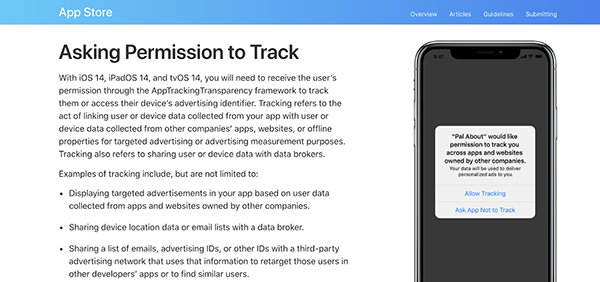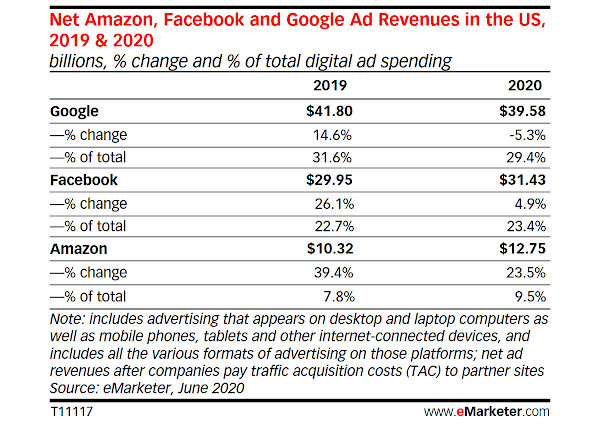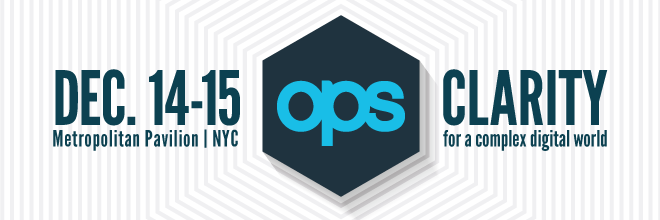 |
||||||||||||
|
||||||||||||
| Apple’s IDFA Goes Opt-In |
 |
| The rumor mill was running wild with speculation that Apple was about to mercilessly slay the iOS app-based advertising tracker, IDFA. Well, good-ish news—IDFA lives! But with iOS 14, it’s opt-in now. Through the newly minted AppTrackingTransparency framework, if an app wants to “track” users and share that data with third parties, they can show a pop-up very similar to the cues asking permission for sharing location data. But what does “tracking” actually include? Among other things, “Displaying targeted advertisements in your app based on user data collected from apps and websites owned by other companies” and “Placing a third-party SDK in your app that combines user data from your app with user data from other developers’ apps to target advertising or measure advertising efficiency, even if you don’t use the SDK for these purposes.” So that would seem to ding the sending of any data to an exchange and leveraging an identity resolution solution. In addition, app-makers will need to share what data they collect and how it’s used on the product page in the App Store. |
| On a consumer level, an opt-in mechanism for data tracking seems like a good policy—basically “app GDPR.” But Apple’s approach is going to make digital media monetization more difficult. The language and positioning of the opt-in seems set to discourage users from agreeing to data-sharing. Then it’s not clear whether a publisher could offer a “free” version of an app that would require turning on tracking to work or suggest users subscribe. Apple must know that app publishers need some kind of data lure to bring in advertisers, so without “tracking,” they’re in the lurch. However, feel free to grumble with the knowledge that Apple wants to build a new ad ecosystem. With this IDFA move, it sounds like a walled garden for iOS apps, and it’s curious what data will inform said advertising. But the scope of the iAd disaster continues to haunt Apple, and its echoes can be felt in publishers' monetization struggles with Apple News. Simply put, iAd failed because Apple would/could not negotiate or compromise with advertisers when it came to their data, reporting, and creative demands, and iOS users could be found elsewhere at a lower price point. We see the same thing happening all over again—the company’s stubbornness may be good for user experience, but not So we think many publishers will just abandon making native apps for iOS. After all, Apple takes a large chunk of flesh with its 30% cut, but if it’s going to make it all the harder to monetize, why bother? Especially when most iOS users dedicate the majority of their time to apps like YouTube, Instagram, TikTok, etc. Especially when PWAs offer an app-like experience in a browser, and identity solutions can enable targeting within Safari (or another mobile browser)? The truly squeezed party will be mobile gaming apps that need native builds and may be stuck with whatever Apple offers. Apple may have thought they were offering publishers a lifeline by not killing IDFA outright, but the end result is likely going to be the same. Any publisher that doesn’t need to be native will probably wave bye-bye. |
| DigiTrust Bites the Dust |
| It’s one more tragic ad tech tale—another bold initiative that seemed on the rise but suddenly felled by a drastically changing space. The IAB Tech Lab’s long-running unified ID program, DigiTrust, is closing up shop at the end of July. The program can’t meet the operating costs of wide publisher adoption, which dramatically increased over the past 18 months. Funding for DigiTrust came from platforms that used the unified ID to cut down on ID (cough, cookie) syncs. But with Google’s Chrome browser doing away with the third-party tracking cookie in the next two years and Mozilla’s Firefox browser deciding to block the ID, new platform partners weren’t keeping up with publisher signups. The costs for partnering platforms were on the up, while revenue and functionality declined. So a meeting of all participants in the program concluded that the best plan of action was to shut it down. |
| We’re really bummed out that the shuttering comes after a period of intense publisher adoption, but we think DigiTrust never evolved enough from its original mission of creating programmatic efficiencies (and efficacies) by minimizing cookie syncs. As the relevance of the cookie has dwindled, the program needed a much wider variety of IDs to survive as a true unified ID, but that requires complex infrastructure and potentially additional data costs. It may seem unnecessary to point out, but any unified ID—whether it’s run by a neutral third party or an active digital advertising player—that’s overly reliant on cookies is going to flame out before Chrome flips third-party cookies off in 2022. Advanced identity resolution providers with robust identity graphs based on a variety of durable identifiers seem set to become the targeting standard of the open programmatic ecosystem… If walled gardens don’t completely take over first. |
 |
| Coronavirus Travel Slump Cuts Google Deep |
 |
| Remember a few weeks ago when we told you we should expect to see a big hit to Facebook and Google’s ad revenues due to the pandemic? Well, it turns out that one side of the duopoly is really hurting. For the first time in forever, eMarketer expects Google’s ad revenue to drop significantly, with US net ad revenues dropping 5.3% to $39.58 billion and US net search dropping 7.2%. The great loss can be attributed to the company’s reliance on the travel industry’s search ad spend. But since the Coronavirus pandemic, the travel industry took a precipitous nosedive. Meanwhile, Facebook is expected to grow 5% this year, which is of course much less than the social media giant’s 26% growth last year. Following consumer behavior during this crisis, DTC and gaming spend have managed to keep the company afloat. And Amazon is expected to grow 23.5%. Together, all three companies are still siphoning a tremendous share of ad spend from other media companies. |
| Last week, when we looked a the road to recovery, the Magna Global numbers we reported pointed to a 5% drop year over year for total ad revenue between 2019 and 2020. If you look at Google’s projected loss, the numbers pretty much line up. We’re talking bad, but we’re not exactly talking dire straits here. On the search front, Amazon has long been digging into Google’s search revenue and when combined with the global pandemic travel slump, you get the kinds of losses we’re seeing in the eMarketer predictions for Google. With the travel industry being the hardest hit from Coronavirus, those dollars are less likely to come back to Google quickly. Could Amazon and Facebook’s growth during the pandemic signal a changing tide in the makeup of the triopoly? Only time will tell. We expect the Alphabet behemoth to once again reach its tentacles into every aspect of digital marketing and advertising once again to take the lead—but not until they finish wading through their antitrust and privacy woes. |
| Blunt Force Blocking #BlackLivesMatter |
| Here goes the keyword blocklist again handicapping publishers by blocking advertisers from supporting important conversations in the media—except this time instead of the Coronavirus it’s #BlackLivesMatter (or conversations about race and racism). The issues with keyword blocking isn’t a new one. In order to maintain brand safety, brands often cut of their nose to spite their face. In a recent article in The Drum, they quote Dr. Augustine Fou, the 'ad fraud investigator', who calls brand safety tech “blunt instruments” and warns: “...that overzealous blocking sends spend downstream “to fraud sites, fake news sites, fake recipe sites, porn sites or piracy sites… where you're lucky if those ‘at scale’ audiences are even a little human.” The tricky thing with #BlackLivesMatter keyword blocking, on one hand we have the issue of blocking important content that has much deeper consumer engagement although it might be related to some negative terms and on the other, we have brands posting black squares on social media in support of the movement but not putting their money behind it. Should content related to BlackLivesMatter protests really be seeing CPMs 57% lower than other content on a verified publisher’s site? Well, that’s exactly what happened to Vice Media. Cybersecurity company Cheq, whose clients include Dentsu, Spark Foundry and ADK, estimates that $2.8 billion was lost due to “incorrect blocking of safe content on premium news sites” in 2019. |
| Have we not learned any lessons from the Coronavirus brand safety shutdown? Just last week, Senior Editor, Lynne d Johnson, moderated a panel discussion—featuring a publisher, ad tech vendor and an agency—at the Virtual Brand Safety Summit, where this very issue was the topic. Two things stood out: 1/ Verified publishers are brand safe and brand suitable, 2/ Sentiment analysis and contextual and semantic analysis should be applied to keyword lists to determine brand safety. It requires more than just a balancing act. It requires strategy—a lot of it. This reminds of us the work the 4A’s is doing to standardize “brand-suitability automation mechanisms.” Unfortunately for publishers, who are providing readers with valuable content, it’s not all happening in real-time. |








